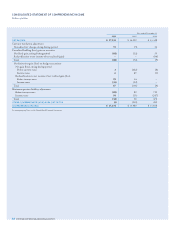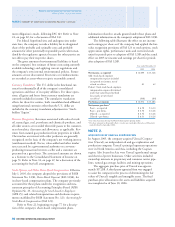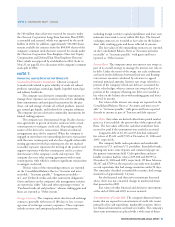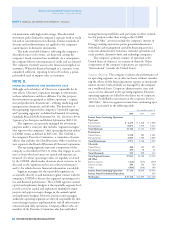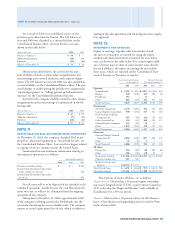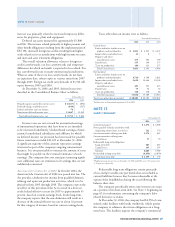Chevron 2006 Annual Report Download - page 64
Download and view the complete annual report
Please find page 64 of the 2006 Chevron annual report below. You can navigate through the pages in the report by either clicking on the pages listed below, or by using the keyword search tool below to find specific information within the annual report.
62 CHEVRON CORPORATION 2006 ANNUAL REPORT62 CHEVRON CORPORATION 2006 ANNUAL REPORT
cial institutions with high credit ratings. This diversifi ed
investment policy limits the company’s exposure both to credit
risk and to concentrations of credit risk. Similar standards of
diversity and creditworthiness are applied to the company’s
counterparties in derivative instruments.
The trade receivable balances, refl ecting the company’s
diver sifi ed sources of revenue, are dispersed among the
company’s broad customer base worldwide. As a consequence,
the company believes concentrations of credit risk are limited.
The company routinely assesses the fi nancial strength of its
customers. When the fi nancial strength of a customer is not
considered sufficient, requiring Letters of Credit is a princi-
pal method used to support sales to customers.
NOTE 8.
OPERATING SEGMENTS AND GEOGRAPHIC DATA
Although each subsidiary of Chevron is responsible for its
own affairs, Chevron Corporation manages its investments
in these subsidiaries and their affi liates. For this purpose,
the investments are grouped as follows: upstream – explora-
tion and production; downstream – refi ning, marketing and
transportation; chemicals; and all other. The fi rst three of
these groupings represent the company’s “reportable segments”
and “operating segments” as defi ned in Financial Accounting
Standards Board (FASB) Statement No. 131, Disclosures About
Segments of an Enterprise and Related Information (FAS 131).
The segments are separately managed for investment
purposes under a structure that includes “segment managers”
who report to the company’s “chief operating decision maker”
(CODM) (terms as defi ned in FAS 131). The CODM is
the company’s Executive Committee, a committee of senior
offi cers that includes the Chief Executive Offi cer and that, in
turn, reports to the Board of Directors of Chevron Corporation.
The operating segments represent components of the
company as described in FAS 131 terms that engage in activ-
ities (a) from which revenues are earned and expenses are
incurred; (b) whose operating results are regularly reviewed
by the CODM, which makes decisions about resources to be
allocated to the segments and to assess their performance;
and (c) for which discrete fi nancial information is available.
Segment managers for the reportable segments are
accountable directly to and maintain regular contact with the
company’s CODM to discuss the segment’s operating activi-
ties and fi nancial performance. The CODM approves annual
capital and exploratory budgets at the reportable segment level,
as well as reviews capital and exploratory funding for major
projects and approves major changes to the annual capital
and exploratory budgets. However, business-unit managers
within the operating segments are directly responsible for deci-
sions relating to project implementation and all other matters
connected with daily operations. Company offi cers who are
members of the Executive Committee also have individual
management responsibilities and participate in other commit-
tees for purposes other than acting as the CODM.
“All Other” activities include the company’s interest in
Dynegy, mining operations, power generation businesses,
worldwide cash management and debt fi nancing activities,
corporate administrative functions, insurance operations, real
estate activities, alternative fuels, and technology companies.
The company’s primary country of operation is the
United States of America, its country of domicile. Other
components of the company’s operations are reported as
“International” (outside the United States).
Segment Earnings The company evaluates the performance of
its operating segments on an after-tax basis, without consider-
ing the effects of debt fi nancing interest expense or investment
interest income, both of which are managed by the company
on a worldwide basis. Corporate administrative costs and
assets are not allocated to the operating segments. However,
operating segments are billed for the direct use of corporate
services. Nonbillable costs remain at the corporate level in
“All Other.” After-tax segment income from continuing oper-
ations is presented in the following table:
Year ended December 31
2006 2005 2004
Income From Continuing Operations
Upstream
United States $ 4,270 $ 4,168 $ 3,868
International 8,872 7,556 5,622
Total Upstream 13,142 11,724 9,490
Downstream
United States 1,938 980 1,261
International 2,035 1,786 1,989
Total Downstream 3,973 2,766 3,250
Chemicals
United States 430 240 251
International 109 58 63
Total Chemicals 539 298 314
Total Segment Income 17,654 14,788 13,054
All Other
Interest expense (312) (337) (257)
Interest income 380 266 129
Other (584) (618) 108
Income From Continuing Operations 17,138 14,099 13,034
Income From Discontinued Operations – – 294
Net Income $ 17,138 $ 14,099 $ 13,328
Notes to the Consolidated Financial Statements
Millions of dollars, except per-share amounts
NOTE 7. FINANCIAL AND DERIVATIVE INSTRUMENTS – Continued


